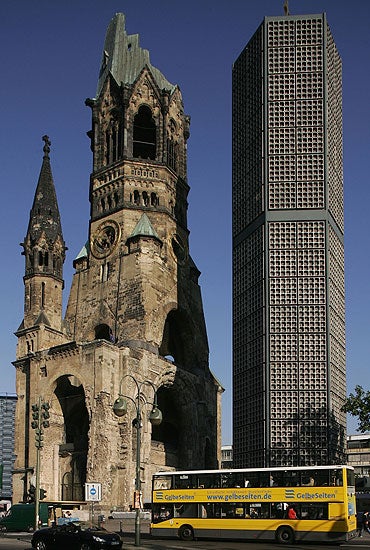'Hollow Tooth' peace symbol of Berlin faces deadly decay threat

Your support helps us to tell the story
From reproductive rights to climate change to Big Tech, The Independent is on the ground when the story is developing. Whether it's investigating the financials of Elon Musk's pro-Trump PAC or producing our latest documentary, 'The A Word', which shines a light on the American women fighting for reproductive rights, we know how important it is to parse out the facts from the messaging.
At such a critical moment in US history, we need reporters on the ground. Your donation allows us to keep sending journalists to speak to both sides of the story.
The Independent is trusted by Americans across the entire political spectrum. And unlike many other quality news outlets, we choose not to lock Americans out of our reporting and analysis with paywalls. We believe quality journalism should be available to everyone, paid for by those who can afford it.
Your support makes all the difference.Its jagged, bomb-shattered belfry towers above the busy streets at the centre of west Berlin like an enormous broken tusk – a ruin that remains one of the most famous and potent symbols of the horrors of war in Europe.
But now Berlin's landmark Kaiser Wilhelm memorial church, nicknamed the "Hollow Tooth" by Berliners, is threatened with closure unless at least €4m (£3.2m) can be found to restore its rapidly disintegrating neo-gothic facades.
City officials admitted yesterday that the 113-year-old building, which is a top tourist attraction, was crumbling so badly as a result of traffic vibration that chunks of it threatened to drop off and hit pedestrians.
"The tower is very badly damaged," said Marko Rosteck, a spokesman for Berlin's urban development office. Church officials have admitted being "stunned" by the findings of a recent surveyor's report on the state of the building.
The church was built between 1891 and 1895 by Kaiser Wilhelm II to honour his grandfather, Kaiser Wilhelm I, the founder of modern Germany.
On the night of 22 November 1943, the church, which stands at one end of Berlin's famous Kurfürstendamm shopping street, was hit by firebombs during a major air raid on the city. The RAF's Lancaster bombers also hit the armaments ministry, the Charlottenburg Palace and the British embassy.
The memorial church was left a blackened, burnt-out and badly shattered ruin. But instead of being demolished like hundreds of other notable buildings in Berlin vociferous public protest ensured that the 223ft-high bell tower was preserved for posterity.
In 1961 an octagonal concrete and glass tower housing a chapel was built alongside the ruined church. The building was consecrated in 1962 on the same day as the rebuilt Coventry Cathedral in an act of reconciliation between the former wartime enemies.
Located in the heart of capitalist West Berlin the church also became a symbol of defiance against Communist oppression.
"The tower is definitely a big symbol for Berlin," said Wolfgang Kuhla, chairman of the memorial church management board. "As a ruin it is certainly the most important memorial for reconciliation in Berlin and possibly in Germany."
Mr Kuhla said around half a million euros had been raised so far from private donations and that his target was one million. Berlin's city government, which is saddled with debts of more than €60m, is planning to provide €1.5m.
Church officials have appealed to the federal government and the public to provide the remaining funding for the restoration which must begin next year to prevent the whole complex being permanently declared off-limits. One of the first to donate cash for the restoration project was the former RAF pilot, Charles Gray, who flew bombing missions over Germany. A supermarket chain followed up by organising a rubber duck race along the city's river Spree to raise cash. Several Berlin artists have offered to auction their works and donate the proceeds to the project.
Berlin's ruling coalition of Social Democrats and members of the former Communist Left Party has been strongly criticised for failing to provide more cash.
One church official insisted that restoring the church was about Berlin and Germany making a gesture to show that it, "remembers and abhors war." "What is the alternative – knock it down and build a shoe shop?" he asked.
Join our commenting forum
Join thought-provoking conversations, follow other Independent readers and see their replies
Comments